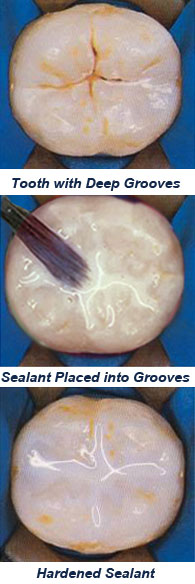How else can I protect teeth from decay?
Sealants protect the chewing surfaces of teeth, but not all surfaces. Good care of the teeth at home along with regular exams and cleanings at your dentist’s office are important. These good habits stop decay from forming in between the teeth spots that sealants cannot cover.
To prevent cavities, brush your teeth twice a day, use floss or another between-the-teeth cleaner once a day, visit your dentist regularly and avoid frequent between-meal snacks. Look for products that display the ADA Seal of Acceptance, which tells you that the product meets ADA standards for safety and effectiveness.

Who should get sealants?
Sealants are most often placed in children and teenagers, since tooth decay can start soon after teeth come in. But adults can bene t from sealants too, because you never “outgrow” the risk for developing cavities. Prevention is always better than treatment. Sealants are very useful in preventing tooth decay on the back teeth and can save patients money in the long run. Your dentist can make sealants part of your plan for a healthy mouth.
Our teeth are constantly being covered with a sticky film of bacteria, called plaque (rhymes with “back”). When we eat or drink anything that contains sugar such as cookies, candy, soda, juice, fruit, milk and many other foods and beverages bacteria turn the sugar into acids that can attack tooth enamel. Over time, repeated attacks may result in decay. The good news is that there is a way to protect your teeth and prevent decay: dental sealants.
Tooth decay often occurs on the chewing surfaces of the back teeth. These surfaces have pits and grooves that trap plaque, bacteria and bits of food. The pits and grooves are hard to keep clean, because toothbrush bristles cannot reach into them. That is how decay starts in the grooves and a cavity forms
How do sealants work?
To keep decay from starting in the grooves of your back teeth, your dentist may recommend dental sealants. A dental sealant is a plastic material that is applied to a chewing surface of a back tooth. The sealant material flows into the pits and grooves in the teeth. The sealant acts as a barrier, protecting enamel by “sealing out” plaque and food.
How are sealants applied?
Sealants are easy to apply, and it takes only a few minutes to seal each tooth. First, the teeth to be sealed are cleaned and prepared to help the sealant stick to the tooth. The sealant is then “painted” onto the tooth enamel, where it bonds to the tooth and hardens. Sometimes a special curing light is used to harden the sealant. Sealants are generally clear or white and cannot be seen when you smile or talk.
How long do sealants last?
Sealants may last several years before they wear out. They hold up well with everyday chewing, but chewing on hard foods, like hard candies, can break down sealants. Sometimes the sealants become worn away or may come off, and the tooth loses its protection. At that time they must be replaced. The dentist looks at the sealants during a dental visit to make sure they are still in good shape

